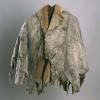Quilt No.221RA - Rozanne Andrew
Made in Tanunda, SA in 1937. Owned by Rozanne Andrew.
The total cost of the rug was 7 pounds, to be tanned and made up. Cats were in plague proportions and were trapped by Mr Alf Schick in Loxton, SA. They were sent to the tannery in Tanunda, which belonged to Juttner, to be made up.
"Further on from last correspondence regarding information on 3 quilts I own from my paternal grandmother. � This is information on grandmother's life. Name - Bertha Fechner & Philip Fechner
D.O.B 19/5/1888 D. 20/12/73 D.O.B 1/6/1893 D. 5/12/46
Lived all their married [lives] at Loxton, South Australia, a town on the River Murray.
Both people of German descent but born in Australia.
Both very frugal in their use of food and possessions. Always preserved all their fruit, killed own animals, grown most of their fruit and vegetables. Grandmother of course made own clothes and many quilts in her lifetime. Many traditions from Germany passed down and carried on through the generations including language. Being able to knit, crochet, sew, embroider an essential part of education. Strong church followers always.
� Grandfather was a blacksmith and wheelright. Grandmother did 'home duties".
[Letter from Rozanne Andrew 20.12.95]






